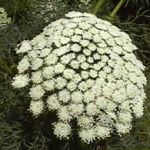| Taking bishop's weed with these drugs may increase the risk of hypotension (excessively low blood pressure): |
| Acebutolol (Novo-Acebutolol, Sectral) |
Acetazolamide (Apo-Acetazolamide, Diamox Sequels) |
Amiloride (Midamor) |
Amlodipine (Norvasc) |
Atenolol (Apo-Atenol, Tenormin) |
Azosemide (Diat) |
| Benazepril (Lotensin) |
Bepridil (Vascor) |
Betaxolol (Betoptic S, Kerlone) |
Bisoprolol (Monocor, Zebeta) |
Bumetanide (Bumex, Burinex) |
Candesartan (Atacand) |
| Captopril (Capoten, Novo-Captopril) |
Carteolol (Cartrol, Ocupress) |
Carvedilol (Coreg) |
Chlorothiazide (Diuril) |
Chlorthalidone (Apo-Chlorthalidone, Thalitone) |
Clonidine (Catapres, Duraclon) |
| Diazoxide (Hyperstat, Proglycem) |
Diltiazem (Cardizem, Tiazac) |
Doxazosin (Alti-Doxazosin, Cardura) |
Enalapril (Vasotec) |
Eplerenone (Inspra) |
Eprosartan (Teveten) |
| Esmolol (Brevibloc) |
Ethacrynic Acid (Edecrin) |
Etozolin (Elkapin) |
Felodipine (Plendil, Renedil) |
Fenoldopam (Corlopam) |
Fosinopril (Monopril) |
| Furosemide (Apo-Furosemide, Lasix) |
Guanabenz (Wytensin) |
Guanadrel (Hylorel) |
Guanfacine (Tenex) |
Hydralazine (Apresoline, Novo-Hylazin) |
Hydrochlorothiazide (Apo-Hydro, Microzide) |
| Hydrochlorothiazide and Triamterene (Dyazide, Maxzide) |
Hydroflumethiazide (Diucardin, Saluron) |
Indapamide (Lozol, Nu-Indapamide) |
Irbesartan (Avapro) |
Isradipine (DynaCirc) |
Labetalol (Normodyne, Trandate) |
| Lacidipine (Aponil, Caldine) |
Lercanidipine (Cardiovasc, Carmen) |
Lisinopril (Prinivil, Zestril) |
Losartan (Cozaar) |
Manidipine (Calslot, Iperten) |
Mannitol (Osmitrol, Resectisol) |
| Mecamylamine (Inversine) |
Mefruside (Baycaron) |
Methazolamide (Apo-Methazolamide, Neptazane) |
Methclothiazide (Aquatensen, Enduron) |
Methyldopa (Apo-Methyldopa, Nu-Medopa) |
Metolazone (Mykrox, Zaroxolyn) |
| Metoprolol (Betaloc, Lopressor) |
Minoxidil (Loniten, Rogaine) |
Moexipril (Univasc) |
Nadolol (Apo-Nadol, Corgard) |
Nicardipine (Cardene) |
Nifedipine (Adalat CC, Procardia) |
| Nilvadipine |
Nimodipine (Nimotop) |
Nisoldipine (Sular) |
Nitrendipine |
Nitroglycerin (Minitran, Nitro-Dur) |
Nitroprusside (Nitropress, Nipride) |
| Olmesartan (Benicar) |
Omesartan and Hydrochlorothiazide (Benicar HCT) |
Oxprenolol (Trasicor, Slow-Trasicor) |
Perindopril Erbumine (Aceon, Coversyl) |
Phenoxybenzamine (Dibenzyline) |
Phentolamine (Regitine, Rogitine) |
| Pinaverium (Dicetel) |
Pindolol (Apo-Pindol, Novo-Pindol) |
Polythiazide (Renese) |
Prazosin (Minipress, Nu-Prazo) |
Propranolol (Inderal, InnoPran XL) |
Quinapril (Accupril) |
| Ramipril (Altace) |
Reserpine |
Spironolactone (Aldactone, Novo-Spiroton) |
Telmisartan (Micardis) |
Terazosin (Alti-Terazosin, Hytrin) |
Timolol (Betimol, Timoptic) |
| Torsemide (Demadex) |
Trandolapril (Mavik) |
Triamterene (Dyrenium) |
Trichlormethiazide (Metatensin, Naqua) |
Urea (Amino-Cerv, Ultramide) |
Valsartan (Diovan) |
| Verapamil (Calan, Isoptin SR) |
Xipamide (Diurexan, Lumitens) |

